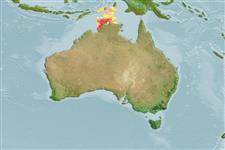>
Clupeiformes (Herrings) >
Engraulidae (Anchovies) > Engraulinae
Etymology: Stolephorus: Greek, stole, -es = garment + Greek, pherein = to carry (Ref. 45335).
Environment: milieu / climate zone / depth range / distribution range
Ecologia
marino; distribuzione batimetrica 0 - 50 m (Ref. 189). Tropical; 7°S - 14°S, 128°E - 135°E (Ref. 189)
Western Central Pacific: known from a single specimen from Saulte Point, Coburg Peninsula, Northern Territory, Australia.
Size / Peso / Age
Maturity: Lm ? range ? - ? cm
Max length : 7.2 cm SL maschio/sesso non determinato; (Ref. 189)
Spine dorsali (totale) : 0; Spine anali: 0; Raggi anali molli: 16. With 7 small needle-like pre-pelvic scutes. Maxilla tip pointed, reaching only just to front border of pre-operculum; hind border of pre-operculum convex, rounded. Isthmus muscle tapering evenly forward to hind border of branchial membrane. Pelvic fin tips presumably not reaching to below dorsal fin origin. No dark pigment lines on back between head and dorsal fin.
Presumably coastal, pelagic and schooling, but more material and data needed. Egg presumed to be oval with a knob (as in S. indicus).
Life cycle and mating behavior
Maturities | Riproduzione | Spawnings | Egg(s) | Fecundities | Larve
Whitehead, P.J.P., G.J. Nelson and T. Wongratana, 1988. FAO Species Catalogue. Vol. 7. Clupeoid fishes of the world (Suborder Clupeoidei). An annotated and illustrated catalogue of the herrings, sardines, pilchards, sprats, shads, anchovies and wolf-herrings. FAO Fish. Synop. 125(7/2):305-579. Rome: FAO. (Ref. 189)
IUCN Red List Status (Ref. 130435)
Threat to humans
Harmless
Human uses
Pesca: commerciale
Strumenti
Special reports
Download XML
Fonti Internet
Estimates based on models
Preferred temperature (Ref.
123201): 28 - 28.8, mean 28.3 °C (based on 46 cells).
Phylogenetic diversity index (Ref.
82804): PD
50 = 0.5000 [Uniqueness, from 0.5 = low to 2.0 = high].
Bayesian length-weight: a=0.00537 (0.00253 - 0.01141), b=3.13 (2.96 - 3.30), in cm total length, based on LWR estimates for this (Sub)family-body shape (Ref.
93245).
Trophic level (Ref.
69278): 3.3 ±0.4 se; based on size and trophs of closest relatives
Resilienza (Ref.
120179): Alto, tempo minimo di raddoppiamento della popolazione meno di 15 mesi (Preliminary K or Fecundity.).
Fishing Vulnerability (Ref.
59153): Low vulnerability (10 of 100).
